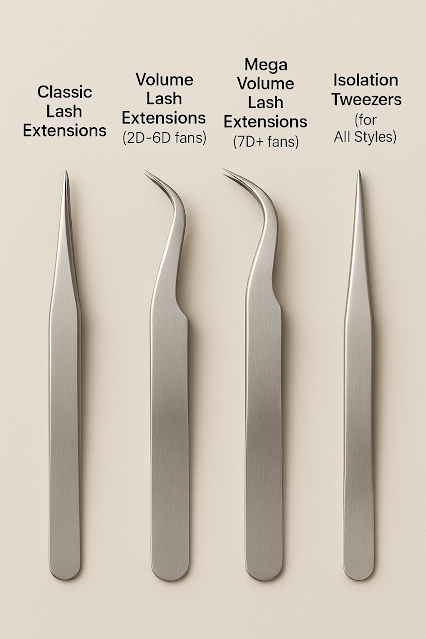Which Tweezer for Which Set? A Lash Style Breakdown
Classic Lash Extensions (1:1)
Attaching one extension to each natural lash is known as "classic lashing." This calls for applying one extension and isolating one lash. The best tweezers are straight (I-shaped), fine-point tweezers. You may apply one extension at a time and isolate individual lashes thanks to the thin, pointed points. For traditional technique, many professionals use extremely lightweight straight tweezers since they provide the most control over a single lash. For extremely accurate positioning or for very short lashes, fine-tip straight or slightly angled tweezers are particularly helpful. To put it briefly, use a straight or angled tweezer with a sharp tip to see and catch that one flawless lash without bothering your neighbours.
As an illustration, for a traditional set, you might use one hand to delicately isolate (separate) a single lash using a straight tweezer, then the other hand to grasp and connect one extension.
Volume Lash Extensions (2D–6D fans)
Small fans (two to six lashes spread out) are applied to each natural lash during volume lashing. The best tweezers are the Boot (wide) and L-shaped (angled) volume tweezers. L-shaped tweezers are "your best friends for volume" because of their bent tips, which allow for smooth and controlled fan-making. They are often held at 45° or 90° angles. They provide a firm hold and the ideal position for picking many lashes and opening a fan on your tile or strip. Boot tweezers are especially well-liked for volume because of their extra-wide, flat tips, which make it simple to fan out and collect several extensions in one clutch.
For added grip, many volume artists additionally employ slanted or fiber-tip tweezers (no-slip tweezers stop the lashes from dropping). To keep the fan together, use a tweezer that is firm but not too bouncy. To make the fan in practice, you may use your dominant hand to grip boot or L-shaped tweezers while isolating the natural lash with the other hand. Pulling the fan causes less shaking because to the combination of a hard, sturdy tweezer and an angled grip. (Tip: since they lessen hand fatigue across a whole set, lighter titanium or stainless tweezers are frequently advised.)
Mega Volume Lash Extensions (7D+ fans)
Mega-volume lashing produces a dramatic, thick look by using very big fans (7–15+ ultra-fine lashes). V-shaped (ultra-fine) and fine-tipped volume tweezers are the best tweezers. A V-shaped tweezer's ultra-fine tip is made to firmly grasp several thin lashes at once. With the help of these tweezers, you can hold a big bundle of lashes that range in length from 0.03 to 0.05 mm together while you dip them in adhesive. For massive volume, fiber-tip or diamond-grip tweezers are particularly common because of their rough surfaces, which provide additional grip to hold hundreds of tiny lashes in place.
You may also use specialised 90° volume tweezers or extremely fine L-shaped tweezers for creating giant fans, particularly if you're lash-ing on a tile (see ergonomic advice below). In conclusion, since each fan is enormous and you need to manage several fibres at once, pick a tweezer that is extremely exact and has additional grip for massive volume.
Isolation Tweezers (for All Styles)
To operate on a single natural lash in a tidy manner, isolation is the technique of separating it. The ideal tweezers for isolation are lightweight and fine-point, allowing you to select one lash softly without upsetting the others. The best tweezers are narrow-tipped isolators that are straight or slightly angled. Though many artists choose an angled isolation tweezer or a small-curved tweezer for improved ergonomics, a totally straight (I-shape) tweezer is the standard for isolation. Your wrist can remain neutral using curved isolators, particularly while working close to the inner corner. In actual use, you separate lashes with the isolation tweezer in your non-dominant hand while attaching the extension with another tweezer with your dominant hand.
The client's eye shape and your method of operation should be taken into account when selecting an isolation tweezer. Since straight and angled fine tweezers are interchangeable, choose the one that best allows you to view the lash line. (A curved tweezer, for instance, may make it simpler to reach a deep-set eye without obstructing the vision.)

.png)

Comments
Post a Comment